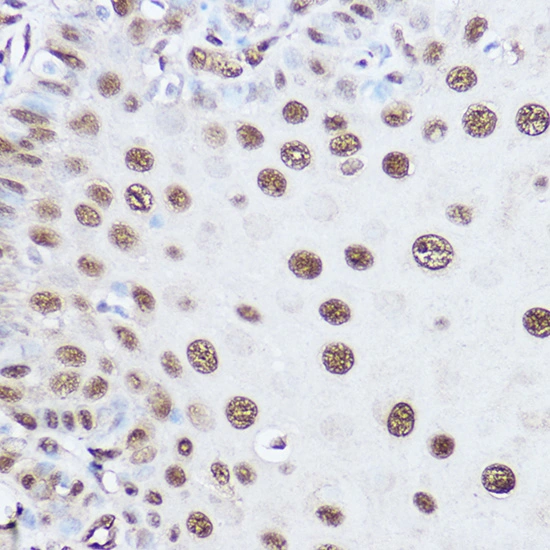SART1 antibody [N2C1], Internal
GTX103371
ApplicationsImmunoFluorescence, Western Blot, ImmunoCytoChemistry, ImmunoHistoChemistry, ImmunoHistoChemistry Paraffin
Product group Antibodies
TargetSART1
Overview
- SupplierGeneTex
- Product NameSART1 antibody [N2C1], Internal
- Delivery Days Customer9
- Application Supplier NoteWB: 1:1000-1:10000. ICC/IF: 1:100-1:1000. IHC-P: 1:100-1:1000. *Optimal dilutions/concentrations should be determined by the researcher.Not tested in other applications.
- ApplicationsImmunoFluorescence, Western Blot, ImmunoCytoChemistry, ImmunoHistoChemistry, ImmunoHistoChemistry Paraffin
- CertificationResearch Use Only
- ClonalityPolyclonal
- Concentration0.76 mg/ml
- ConjugateUnconjugated
- Gene ID9092
- Target nameSART1
- Target descriptionspliceosome associated factor 1, recruiter of U4/U6.U5 tri-snRNP
- Target synonymsAra1, HAF, HOMS1, SART1259, SNRNP110, Snu66, U4/U6.U5 tri-snRNP-associated protein 1, IgE autoantigen, SART-1, SART1(259) protein, SART1(800) protein, SART1, U4/U6.U5 tri-snRNP-associated protein 1, SNU66 homolog, U4/U6.U5 tri-snRNP-associated 110 kDa protein, hSART-1, hSnu66, hypoxia associated factor, small nuclear ribonucleoprotein 110kDa (U4/U6.U5), squamous cell carcinoma antigen recognised by T cells, squamous cell carcinoma antigen recognized by T-cells 1
- HostRabbit
- IsotypeIgG
- Protein IDO43290
- Protein NameU4/U6.U5 tri-snRNP-associated protein 1
- Scientific DescriptionThis gene encodes two proteins, the SART1(800) protein expressed in the nucleus of the majority of proliferating cells, and the SART1(259) protein expressed in the cytosol of epithelial cancers. The SART1(259) protein is translated by the mechanism of -1 frameshifting during posttranscriptional regulation; its full-length sequence is not published yet. The two encoded proteins are thought to be involved in the regulation of proliferation. Both proteins have tumor-rejection antigens. The SART1(259) protein possesses tumor epitopes capable of inducing HLA-A2402-restricted cytotoxic T lymphocytes in cancer patients. This SART1(259) antigen may be useful in specific immunotherapy for cancer patients and may serve as a paradigmatic tool for the diagnosis and treatment of patients with atopy. The SART1(259) protein is found to be essential for the recruitment of the tri-snRNP to the pre-spliceosome in the spliceosome assembly pathway. [provided by RefSeq]
- Storage Instruction-20°C or -80°C,2°C to 8°C
- UNSPSC12352203
References
- Sundararaman B, Zhan L, Blue SM, et al. Resources for the Comprehensive Discovery of Functional RNA Elements. Mol Cell. 2016,61(6):903-13. doi: 10.1016/j.molcel.2016.02.012Read this paper







